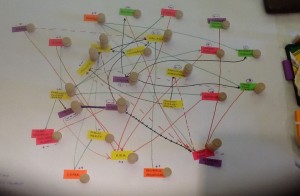As part of our efforts to keep up with the trends in strategic communication, my wonderful organisation allowed me the pleasure of spending 3 fantastic days in beautiful Nairobi, Kenya for the first ever Net-Map Training held in Africa. Hosted and coordinated by Kentice Tikolo and her team at Impact Africa, a small group of communications practitioners from Africa were lucky enough to be trained by Amitaksha Nag.
Stakeh older mapping is the foundation upon which every good strategy is built. If you don’t know who your organisation is targeting with its services/products, your chances of success are drastically compromised. But stakeholder mapping isn’t always enough. If you are interested in shaping attitudes, changing perceptions, influencing policy or any other equally difficult change process, you have to take stakeholder mapping to another level of conceptualisation. Not only do you need to know who, but you equally have to identify how these actors can contribute to your change effort.
older mapping is the foundation upon which every good strategy is built. If you don’t know who your organisation is targeting with its services/products, your chances of success are drastically compromised. But stakeholder mapping isn’t always enough. If you are interested in shaping attitudes, changing perceptions, influencing policy or any other equally difficult change process, you have to take stakeholder mapping to another level of conceptualisation. Not only do you need to know who, but you equally have to identify how these actors can contribute to your change effort.
Simple enough… Well yes, but let’s add another layer that allows us to identify and leverage the formal and informal relationships that exist among our stakeholders and the subsequent power/influence that each stakeholder has to lead us to our desired outcome. This becomes a little more difficult, but as I recently learnt Net-mapping can help us do just that.
What is Net-mapping you ask? Net-map is a fantastic tool created by Eva Schiffer. It allows individuals to explore and envision the relationship between stakeholders through exploring the formal and informal relationships that exist among them. It also analyses the influence of each stakeholder in achieving the desired outcomes and how these formal or informal networks can be utilised to achieve change or better understand a specific concept. It is simply a tool that allows you to map your networks using relationships as the foundation of this analysis.
The best way to describe this interesting process of influence mapping is to set about highlighting some of its basic principles.
- Identify a clear and specific question of change: The more specific you are the better. For instance you may want to ask yourself, who influences who in implementing the forest fire management policies in Zimbabwe.
- Identify and categorise stakeholders: Through the help of colourful post-it notes, identify and divide your stakeholders into groups. This allows you to have broad categories of actors that are divided into specific players and can therefore be scattered across your influence map.
- Identify the formal and informal links between these multiple actors: An example of a formal link would be formal reporting links between actors, an informal link would be friendship or indirect money flows (corruption).
- Create influence towers: Stack wooden blocks to represent influence. If an actor is particularly influential in helping you to achieve a particular change, give them the highest influence tower (e.g. 8 blocks).
- Identify supporters and detractors: Indicate if each actor is a positive or negative influence in helping you to achieve the change you want to see.
 Through this process what you hope to gain is a map that illustrates the relationship between different actors, identifies actors you should focus your efforts on, allows you to identify potential allies and detractors and allows you to discover relationships that you may not have been consciously aware of.
Through this process what you hope to gain is a map that illustrates the relationship between different actors, identifies actors you should focus your efforts on, allows you to identify potential allies and detractors and allows you to discover relationships that you may not have been consciously aware of.
Inviting multiple key actors to this mapping process may allow you to tap into more sources of knowledge both tacit and explicit; however, Net-map can also be used for personal reflection to help individuals make strategic decisions.
What I like most about Net-mapping is that it focuses on the simple components of engagement that we tend to forget. Relationships are fundamental to all interactions, they are the foundation upon which we build; yet, we tend to overlook their strategic importance when we are analysing our capabilities to influence change. Net-mapping hones in on this making it a refreshing way to look at influence and also a useful process of introspection for both organisations and individuals.
If you are interested in trying Net-Mapping for yourself and your organisation, contact us at info@commsconsult.org. You won’t regret it!

Leave a Reply